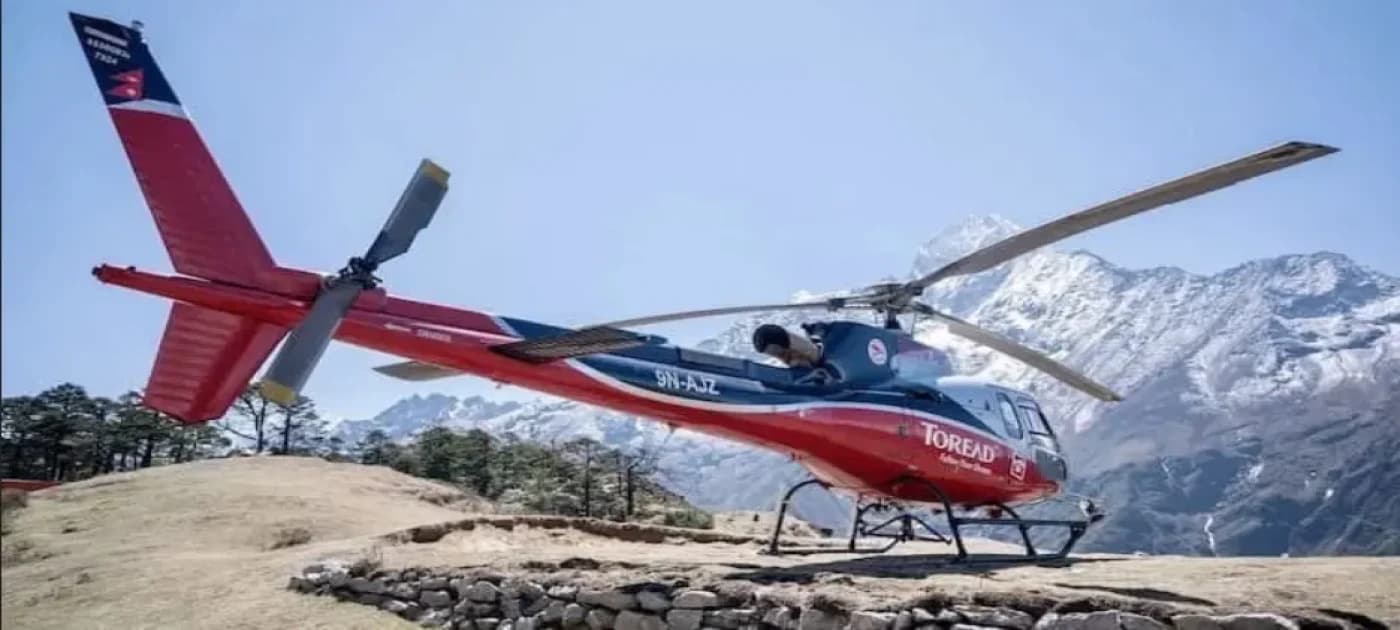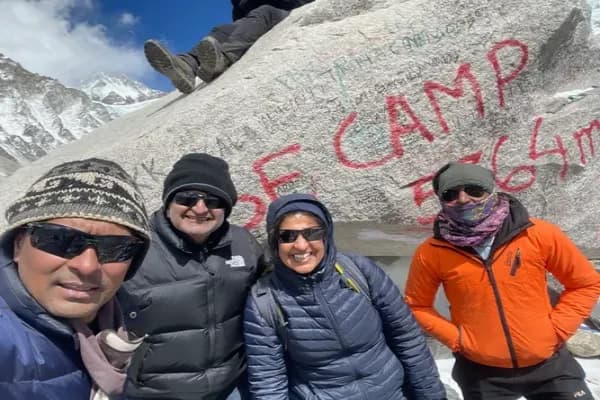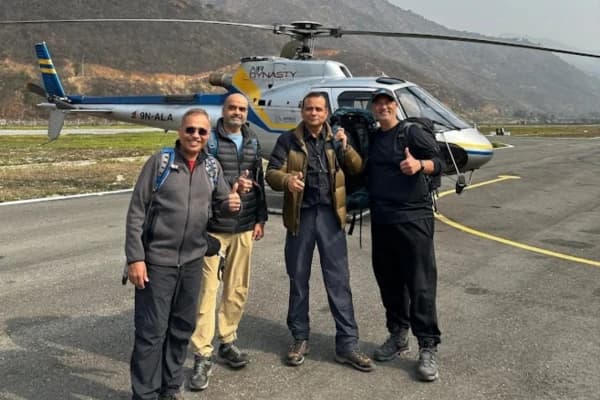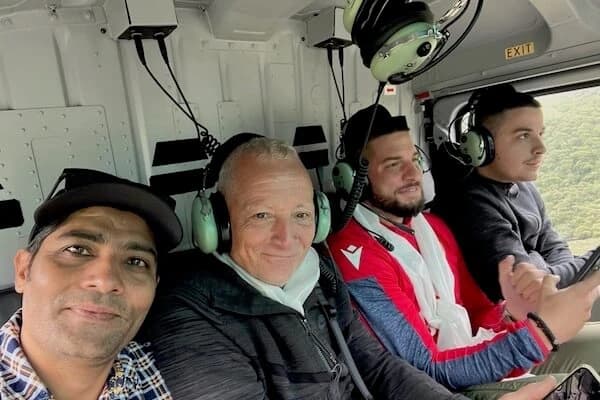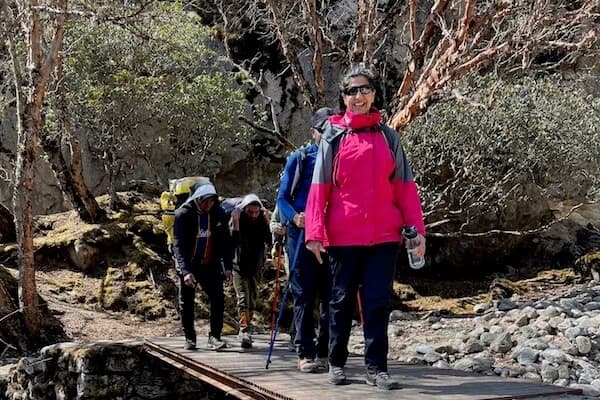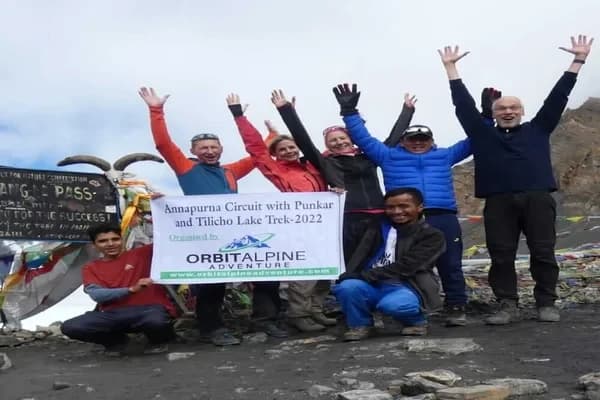After reaching Everest Base Camp, many trekkers are now choosing to return by helicopter. This smart upgrade saves you 3–4 days of walking, reduces the risk of altitude sickness, avoids Lukla flight delays, and offers stunning aerial views of the Himalayas. Whether you’re short on time, physically tired, or simply want a scenic and comfortable finish to your trek, flying back is a safe, stylish, and memorable option. In this article, we’ll explore the top 10 benefits of taking a helicopter return from EBC, from convenience and comfort to once-in-a-lifetime mountain views.
Why Choose a Helicopter Return After the Everest Base Camp Trek? 10 Benefits You Should Know
Imagine standing proudly at Everest Base Camp, feeling the excitement of finishing one of the world’s most famous treks. Now, instead of walking all the way back on the long and tiring trail, picture yourself flying above the clouds in a helicopter, looking down at the amazing Himalayas stretching out below.
Taking a helicopter back from Everest Base Camp is not just for luxury anymore. It’s becoming a smart and popular choice for trekkers who want to save time, stay safe, and end their journey in a special way. It is a best short treks in Nepal option. Whether you don’t have many days left, feel very tired, or just want a beautiful view from the sky, this option gives you all that.
Flying back by helicopter saves you 3 to 4 days of walking downhill. It also helps you avoid the uncertain flights from Lukla airport, and gives you stunning views of Everest, Lhotse, and Ama Dablam from above. It is a safer way down too, because it lowers the chances of altitude sickness and makes your trip more comfortable and stylish.
In this blog, we will look at the top 10 reasons why choosing a helicopter return after trekking to Everest Base Camp might be the best choice for you. From saving time to enjoying amazing views and luxury, you’ll see why more and more trekkers prefer to fly back from EBC. Ready to take your return to the next level? Let’s get started.
Save Time on the Way Back
Trekking to Everest Base Camp means hiking for many days through beautiful but tough land. But after you reach your goal, the walk back can feel very long and tiring. Taking a helicopter back saves you three to four days of walking downhill on the same path.
This quick return is perfect for trekkers who don’t have a lot of time. Instead of walking all the way back to Lukla, you can fly from Gorakshep or Lobuche and get to Kathmandu or Lukla in just a few hours. Choosing an Everest Base Camp Trek Return by Helicopter gives you extra time to rest, see more of the city, or even catch your next flight without feeling rushed. If you are still planning the trek itself, here’s a complete guide on how to prepare for Everest Base Camp.
Avoid Retracing the Same Trail
The Everest Base Camp trek trial is beautiful, but the way back is usually just the same path in reverse. Walking again over the rocky paths, suspension bridges, and through the forests can feel boring and repetitive.
Taking a helicopter ride from Everest Base Camp means you don’t have to walk back at all. Instead, you get to see the Himalayas from a totally new view, without repeating the steps you already took. A helicopter ride at the end keeps the adventure exciting, even after you’ve reached your main goal.
Get a Bird’s Eye View of the Himalayas
Flying back by helicopter gives you some of the most amazing views you’ll ever see. Imagine looking down from the sky at Mount Everest, Lhotse, Ama Dablam, and the huge Khumbu Glacier.
Seeing Everest from the air feels like magic. You’ll fly above snowy mountain tops, twisting rivers, and the small Sherpa villages high up in the mountains. It’s a completely different way to enjoy the beauty of the area, something you just can’t get while walking on the trail.
Highlights from the Sky
- Enjoy top-down views of Everest and nearby peaks
- See glaciers, ridges, and remote villages clearly
- See the huge Himalayan landscape all at once in one amazing view.
What You’ll See on the Flight
During the Everest helicopter ride, look out for:
- Mount Everest (8,848m)
- Lhotse and Nuptse
- Ama Dablam
- The Khumbu Icefall
- Tengboche Monastery
- Gokyo Lakes (on clear days)
The Everest helicopter flight route is like a visual journey through Nepal’s highest and most remote areas.
Easier Descent for Tired Trekkers
Getting to Everest Base Camp is a big physical challenge. After days of climbing uphill, the way back can be hard, especially for beginners or those not used to the high mountains. Your legs might hurt, your knees may ache, and you could feel very tired.
Taking a helicopter is a much easier and more comfortable choice. It’s great for people who want to avoid the hard walk down steep, rocky paths. Flying down from Everest Base Camp helps you recover faster and enjoy the rest of your trip.
Skip the Rough Downhill Terrain
Picking a helicopter ride to go down from Everest Base Camp means you don’t have to deal with slippery paths, steep downhill climbs that hurt your knees, or rough rocky spots that might cause injuries. It’s a calm and safe way to return that protects your body and helps you stay relaxed.
If your knees bother you or you’re already feeling tired, this is the best and most comfortable way to finish your trip.
Minimize Risk of Altitude Sickness on Return
Altitude sickness is a common worry on high mountain treks. Even though you go down after reaching Everest Base Camp, some people still feel sick while coming back. Taking a helicopter is a safe option which lets you go down much faster, lowers the chance of getting Acute Mountain Sickness (AMS).
This makes helicopter and altitude sickness prevention a major benefit. You’re not just saving time, you're also making a safer choice for your body.
AMS Risk on Return vs. Helicopter Option
Flying down quickly in a helicopter helps your body get more oxygen faster, so you feel better sooner. Walking down slowly means you stay at high places longer, which can increase the chance of health problems.
Enjoy Luxury & Comfort in the Mountains
After many days of staying in simple tea houses, sharing bathrooms, and walking long distances, taking a helicopter feels like a special treat. This fancy way to return gives you a smooth and stylish finish to your Himalayan trip.
With luxury Everest Base Camp helicopter services, you can choose a private ride or share one with others, whatever you prefer. It’s especially popular with honeymooners or travelers who want comfort and style in the mountains.
Ideal for Premium Travelers or Couples
A private helicopter ride is a romantic and unforgettable experience. Whether you’re celebrating a special moment or just want to spoil yourself, this fancy option is definitely worth thinking about.
Best for Weather-Triggered Emergencies
The weather around Everest can change very quickly. Snowstorms, strong winds, or thick fog can come without warning. When this happens, walking back might be unsafe or even impossible. So, before visiting do check the best time to visit the Everest so that you don't have to face any obstacle.
Helicopters provide a fast and flexible way to leave. If the weather suddenly turns bad, emergency helicopter flights from Everest Base Camp can get you out quickly and safely. You don’t have to risk walking in dangerous conditions when a chopper can pick you up in just minutes.
Capture Amazing Photos & Videos
Flying over Everest gives you the chance to take amazing pictures and videos that you can’t get from the trail. The views from the helicopter are perfect for using your camera or GoPro.
Taking photos by helicopter is like having your own drone, but even better because you’re inside it. With mountains all around and no other people nearby, your photos will be truly special and one of a kind.
Tips for Great Aerial Shots
- Sit near the window for wide, clear views
- Use fast shutter speed to avoid motion blur
- Be ready with your camera settings before takeoff
- Morning light is best for sharp, clear shots
Avoid Unpredictable Flight Delays at Lukla
Lukla Airport is famous for flight delays. Fog, rain, and strong wind often stop planes from flying for hours or even days. If you are waiting for a flight from Lukla to Kathmandu, you might get stuck without warning.
Choosing a helicopter ride from Gorakshep or Lobuche means you don’t have to go through Lukla at all. Helicopters can fly even when planes cannot, making your trip back much more reliable.
Lukla Weather Conditions
Fog and low visibility often cause problems at Lukla Airport. But helicopters can fly in smaller windows of good weather and land in more flexible places, giving you a better chance to leave on time.
Ends the Trek on a High Note
Ending your trek with an exciting helicopter ride feels really special. After all the hard work, it’s like a well-deserved reward. The unforgettable flight away from Everest is something you’ll remember and talk about for years.
Flying away while the mountain peaks slowly fade below you is a true “wow” moment that makes your adventure one you’ll never forget.
The Wow Moment: Helicopter Pickup at High Altitude
Getting picked up by a helicopter from a place like Gorakshep, one of the highest points trekkers reach, adds an exciting twist to your trip. The loud sound of the chopper coming in and the wind blowing all around you feels just like a scene from a movie.
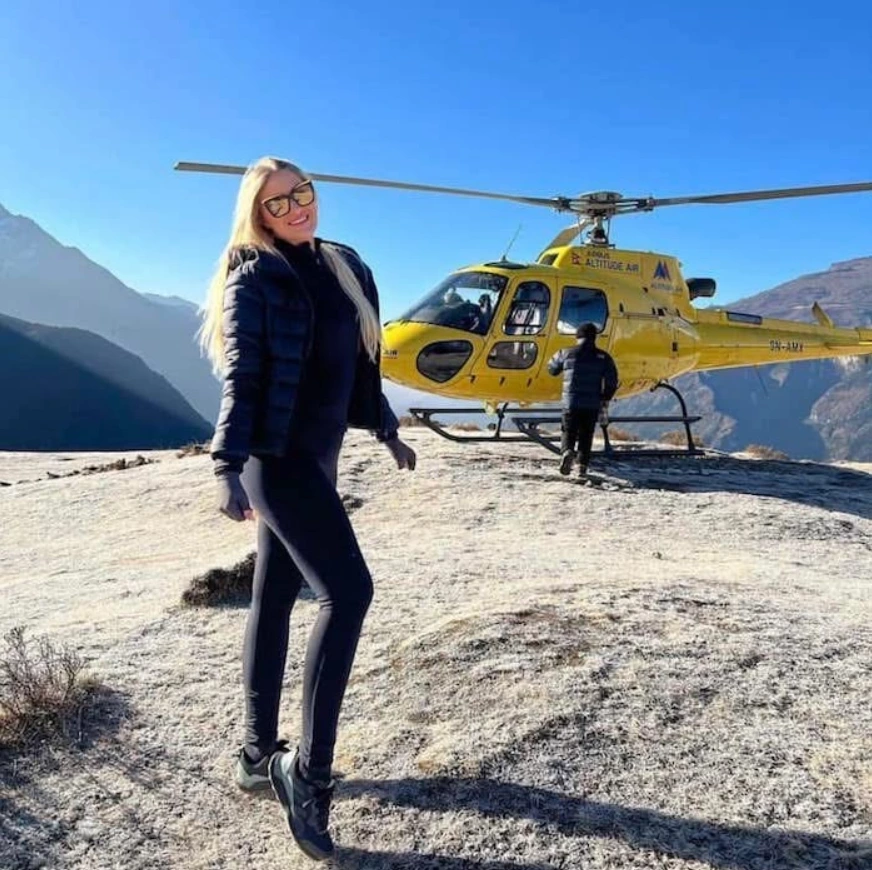
How Much Does a Helicopter Return Cost?
The cost of a helicopter ride back from Everest depends on how many people are in your group and what time of year you go. If you are a solo traveller, then it’ll cost you $2295, but if you have a group, then you’ll get a bulk discount which will be $1995 per person.
It might seem like a lot, but when the price is shared with others, it becomes more affordable. Plus, when you think about the days you save, the comfort you get, and the safety it offers, it’s really a good value for your money.
Things to Know Before Booking a Helicopter Return
Before you confirm your helicopter ride, keep a few things in mind:
- Book early during peak season to secure a seat
- Check if your travel insurance covers helicopter evacuation
- Choose reliable operators with safety records
- Be aware of weight limits and weather delays
- Try to sit on the left side for better views when flying toward Kathmandu
- Everest Base Camp Trek guide will help you make an informed and safe decision.
Should You Choose a Helicopter Return?
If you want to save time, skip the hard walk down, and enjoy a one-of-a-kind view of the Himalayas from above, then yes, a helicopter ride back from Everest Base Camp is totally worth it.
It’s a great choice for trekkers who are low on time, feeling very tired, or just want to end their trip with comfort and style. Whether it’s your first trek or you’ve been here before, this amazing flight is the perfect way to finish your adventure, and Everest Base Camp is also included in the top 10 must-do treks in Nepal.
Frequently Asked Questions (FAQs)
Is a helicopter return from Everest Base Camp safe?
Yes, helicopter returns from EBC are very safe. The pilots are trained for high-altitude flights and know how to handle mountain weather conditions. Most flights are run by experienced companies that follow strict safety rules.
How much does it cost to return by helicopter?
The cost usually ranges from $1995 to $2295 depending on the group size, season, and flight type. A shared helicopter is more affordable, while a private flight costs more but offers extra comfort and privacy.
Can I share a helicopter with others?
Yes, you can. Most trekkers choose to share the helicopter ride to split the cost. This makes it more budget-friendly while still offering the same great views and comfort.
Where are the common helicopter pickup locations?
Helicopters usually pick up trekkers from Gorakshep or Lobuche. These are the last major stops near Everest Base Camp where helicopters can safely land based on weather and space.
How long does the helicopter ride take?
The ride from EBC to Kathmandu usually takes about 1.5 to 2 hours. This includes a short stop for refueling, often at Lukla or Pheriche, depending on the route.
Is prior booking required for a helicopter return?
It’s best to book in advance, especially during the busy trekking seasons. Booking early ensures you get a seat and avoid last-minute surprises or delays due to full flights.
What if the weather is bad on the return day?
If the weather is bad, the flight may be delayed until it is safe to fly. Operators closely monitor weather conditions and wait for a clear window before taking off. Safety is always the top priority.
Will rapid descent cause altitude issues?
No, it won’t. You are descending quickly, which helps reduce altitude sickness risks. Most trekkers feel better as oxygen levels rise during the descent.
Can I take photos during the flight?
Yes, absolutely. In fact, many people choose the helicopter return just to capture amazing photos and videos from the air. Just make sure your camera or phone is ready before takeoff.
Does my travel insurance cover a helicopter return?
That depends on your policy. Some insurance plans cover helicopter evacuation only for emergencies, not planned returns. Always check with your provider before your trek.
